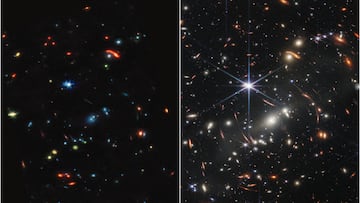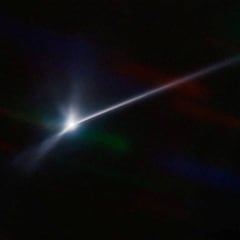James Webb Space Telescope spots “most primitive galaxy” ever seen
Researchers have identified ‘green pea’ galaxies deep in outer space that are thought to date back more than 13 billion years.


The James Webb Space Telescope has unearthed more incredible insight about the universe, identifying evidence of what is thought to be the most primitive galaxies ever identified from earth.
The images captured of the ‘Green Pea’ galaxies are thought to show them just 700 million years after the Big Bang. The objects in question are so far away that it has taken roughly 13 billion years to reach earth.
“We’re seeing these objects as they existed up to 13.1 billion years ago, when the universe was about 5% its current age,” said Sangeeta Malhotra, a researcher at NASA Goddard who was involved in the discovery.
“And we see that they are young galaxies in every sense - full of young stars and glowing gas that contains few chemical products recycled from earlier stars.”
The galaxies were visible in the James Webb Space Telescope’s first image, released back in July 2022, but it has taken months for the team to identify exactly what they are. The findings were published earlier this month in Astrophysical Journal Letters.
Rare 'green pea' galaxy may be the most 'chemically primitive' galaxy ever discovered https://t.co/VKcANj934I pic.twitter.com/dOu8jdfoJ1
— SPACE.com (@SPACEdotcom) January 11, 2023
What is a ‘green pea’ galaxy?
The name ‘green pea’ galaxy comes from the visible appearance from earth, a result of their young age and chemical make-up. The galaxies are comprised of brightly glowing gas clouds which give them a greenish hue and they are typically very compact, only around 5% of the size of our Milky Way. As they are so young and so dense, they are often very fertile grounds for the production of new stars.
They were first discovered in 2009 during a project called Galaxy Zoo in which volunteers and citizen scientists were invited to help classify galaxies. The small, unresolved greenish dots were picked up on by those involved and their composition was investigated using infra-red technology.
“Peas may be small, but their star-formation activity is unusually intense for their size, so they produce bright ultraviolet light,” said Keunho Kim, who was part of the James Webb analyst team.
Related stories
That work was built upon by researchers operating the James Webb telescope, using its Near-Infrared Spectrograph (NIRSpec) instrument to record the colour spectra of selected galaxies. They found that the emission of light associated with oxygen, hydrogen, and neon matched perfectly with other examples of green peas previously identified.
One of the aims of the James Webb mission was to gain greater insight into the origin and history of the universe, and these green pea galaxies could help to explain how the 13-billion-year process unfolded.

